January’s Fungi Focus: Crimped Gills

They grow in dense overlapping tiers on dead stumps and branches, the felty topside of these semi-circular shelves primarily an orange to tawny brown colour demarcated to form zones of different colours, including a rather striking blue in places, and tending towards white at the edges. The Crimped Gill, or Plicatura crispa (also Plicaturopsis crispa), does indeed from such descriptions, sound remarkably similar to the Turkey Tails described in last month’s post.
In these winter months when bracket fungi are plentiful in our woodlands, there are a good number of fungi that might be confused with Turkey Tails, in fact, from the False Turkey Tails and Hairy Curtain Crusts described last month, through the Tripe Fungus covered in a Fungi Focus from last February and other lookalike species such as the Smokey Bracket (Bjerkandera adusta).
However, Crimped Gills seem to be out in force at the moment in certain parts of the country, and for this reason warrant much closer attention, because according to Alick Henrici in an article published in the April 2018 issue of Field Mycology entitled ‘Plicatura crispa - spreading rapidly in Britain’, it wasn’t always thus. In fact, the species was considered “until recently little known in Britain outside Scotland though very widespread in Europe… [its] British range has increased dramatically this century, especially since 2010, for reasons that remain mysterious.”
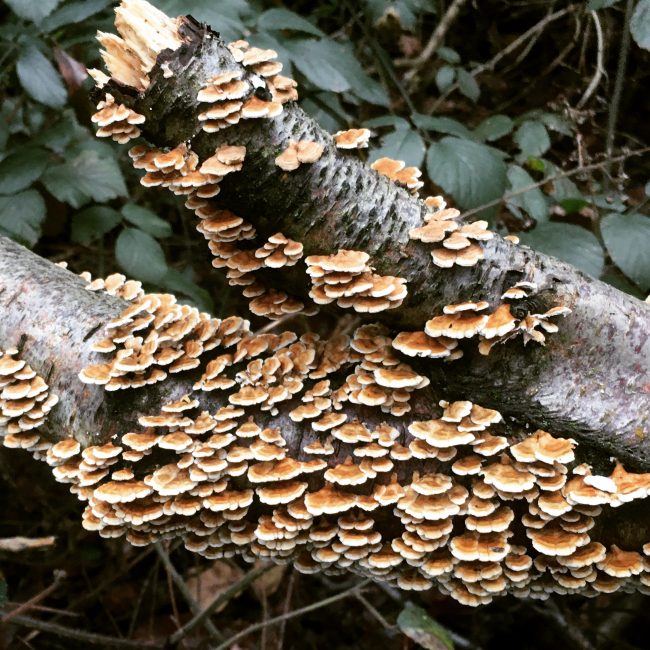
Plicatura crispa
As an example of its expansion, I remember finding my first specimen growing on a single fallen tree in a woods just outside Canterbury in December of 2018. I found the first batch for this past season in my local woods near Bromley in early November, on a fallen log, but just heading out over the first few weeks of the new year, and I’ve discovered them sprouting all over the place in my local woods. It is astonishing to discover then that there were no records at all for the whole of Kent until Joyce Pitt found the first Crimped Gills here in 2006. It is interesting to note that many of my old field guides do not include this species at all, because I think it is safe to say that the Crimped Gill is a pretty common find these days.
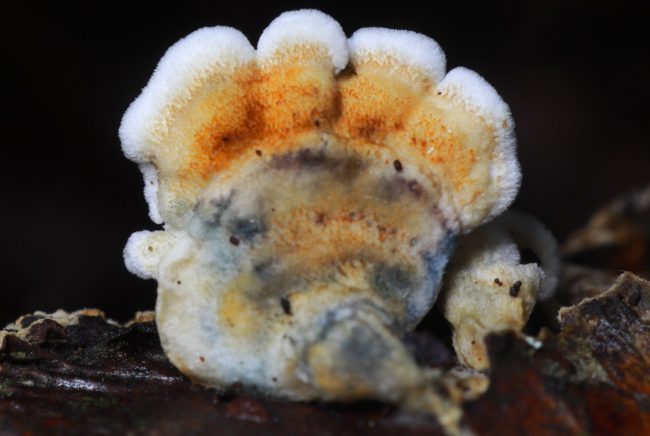
I think we can easily scotch the idea that the earlier lack of records might be due to it being confused with Turkey Tails. As any mycologist knows, one of the first thing you should do when trying to identify a mushroom is look underneath, and as superficially similar as the two might be when viewed from above, a look beneath should quickly dispel any doubt.
The spore-releasing surface, or hymenium, on the underside is neither covered in pores, nor is it smooth like some of the Turkey Tail lookalikes, but seemingly gilled. Actually, this is not quite the case – these aren’t in fact true gills that can detached from the rest of the fruiting but, but branching ridges in the hymenium that look much like gills. You can see something similar with chanterelles, and I described this “false gill” phenomenon on Birch Mazegills in a post from last year. Essentially the Crimped Gill is a corticioid, like so many crust and bracket fungi, in that its spore releasing surface is smooth, albeit heavily wrinkled.
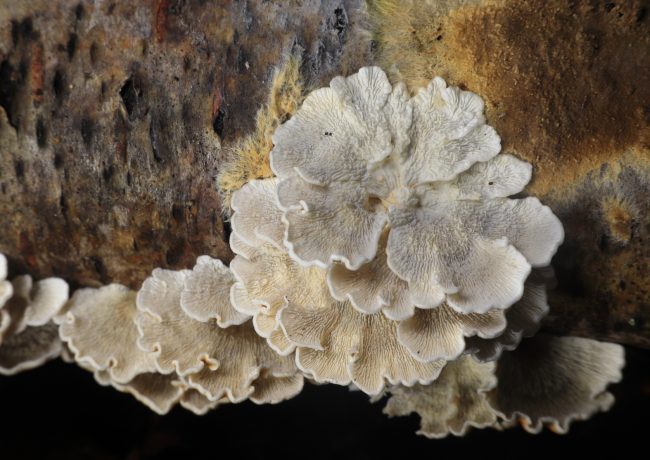
The veined underside, then, is the real giveaway when it comes to identifying Crimped Gills, but there are several other details that distinguish it from Turkey Tails. Firstly, the flesh is not particularly tough like most brackets, but the individual fruit bodies are pliant and easily torn, before they turn brittle with age. They are also not very big, at around 1-2cm across compared with the diameter ranging up to 10cm of Turkey Tails.
The shape is also pretty distinctive once you get more familiar with the various bracket types. Laessoe and Peterson’s Fungi of Temperate Europe describes it as “mussel-shaped”, and the cap as “inrolled and wavy”. It is the ridged margins, rather like the edge of a pie, that accounts for the species’ common name of the Crimped Gill, as well as the second part of its binomial: crispa is the Latin word for curly or crimped (there’s another fungus, the Wood Cauliflower, with the scientific name Sparissa crispa).
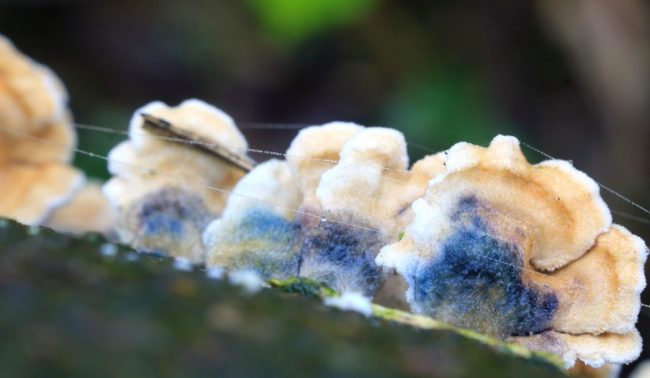
Laessoe and Peterson claim that the Crimped Gill is restricted to the bark of various deciduous trees, especially on standing dead trunks and hanging branches, so it would be interesting to see if it has ever been recorded on decorticated or bark-less wood. 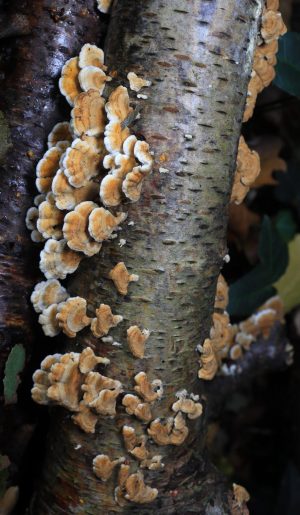 Henrici’s article mentions that the bulk of the records have been on the three main hosts of beech, birch and hazel, but notes records of it discovered on the wood of a number of different deciduous trees.
Henrici’s article mentions that the bulk of the records have been on the three main hosts of beech, birch and hazel, but notes records of it discovered on the wood of a number of different deciduous trees.
As Henrici details, the first ever recordings of this fungus were as long ago as 1868 when it was found by a certain Archibald Jerdan in Roxburghshire, on the southern border of Scotland. Most of its early records seem to be from Scotland or the north of England, but even then it hardly seems to have been a common find, until fairly recently, and “78% of all P. crispa records in FRDBI [Fungal Records Database of Britain and Ireland] and most of those in CATE [Fungus Conservation Trust database] are from the year 2000 onwards.” Indeed, scouring the CATE database, one notes the northerly distribution, with many of the non-Scottish records found in regions like Yorkshire and Cheshire. As previously mentioned, it was not reported in the southeast until its discovery in Kent in 2006, but successive recordings show that “it is now fairly widespread in Kent, Surrey and Sussex and in places common and conspicuous.” I can personally vouch for its ubiquity in Kent.
Henrici also writes that the first southern records precede the Southeast recordings, dating back to 1996, when it was found near Salisbury on four separate occasions over five years. These seem to be the only four records from Wiltshire, at least at the time the article was written. The Crimped Gill has yet to be found anywhere in the Midlands, Wales or the Southwest.
There are some interesting questions raised by these findings beyond the most obvious one of why there has been such an explosion of Crimped Gills across the United Kingdom over the past decade. Climate change is usually held accountable for species migration or differences in fruiting and flowering patterns, but why would we then be seeing the largest amount of recordings spreading from the coldest wettest parts of the British isles in Scotland to the driest, warmest and least windy areas of the Southeast right at the opposite end of the British Isles, apparently skipping out much of the land in between?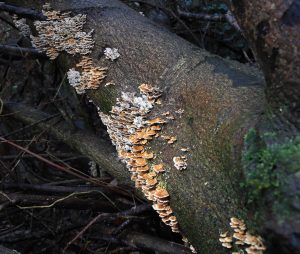
Sadly, mycology remains a massively underfunded and under-researched field (as might be gathered by the sheer unwieldiness of the FRDBI and CATE databases!), and much of what we know about fungi distribution in the UK is due to the voluntarily activities of mycological groups or passionate individuals. Surely the case of the relentless march Westwards of the Hymenoscyphus fraxineus fungi responsible for Ash Dieback highlights the importance of trying to record fungi distribution to understand fungi’s role with keeping our natural ecosystems in check?
The Crimped Gill fungus clearly doesn’t have such a dramatic or devastating effect on British woodlands as the Ash Dieback. It is a white-rotting saprotroph, that degrades the lignin and cellulose of dead wood, leaving it bleached white and stringy. It doesn't harm living trees.
Henrici’s article does highlight the importance of anecdotal evidence in the form of field recordings by amateur experts (I use the term in the sense of non-professional and unpaid rather than unknowledgable) in building up a system of knowledge about the world we inhabit, but also its limitations: we might see that something new is happening in a certain place it wasn’t before, but we don’t know why or what it’s ramifications are.
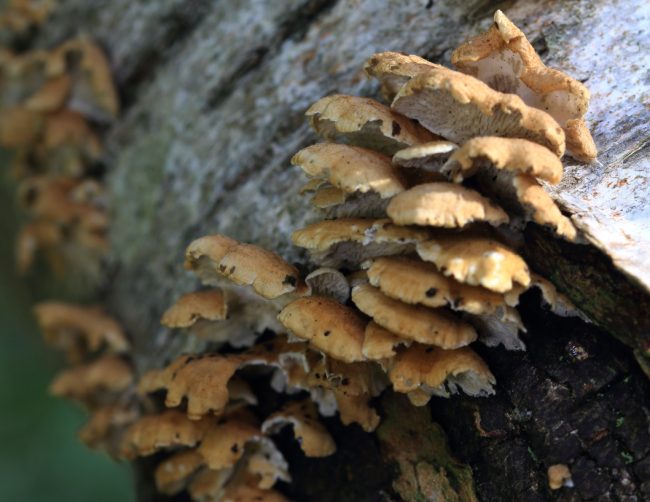
Could the Crimped Gill be outcompeting other fungi species for example? Or perhaps even mutually beneficial? To add my own unscientifically backed-up observation, further along the fallen trunk on which I found my first, rather small patch of this species in 2018, there was the distinctive pinkish flourish of the Silverleaf fungus (Chondrostereum purpureum). Two years later, on the same trunk and at the same time of year, the Crimped Gills had proliferated much further up this huge shared substrate to where the Silverleaf had been, but there was now no sign of the fruiting body of the Silverleaf itself.
This is just an individual observation, and it might not have any weight behind it. After all, many individual fungi can coexist in the same substrate without necessarily all producing fruiting bodies. It does raise a question about the Crimped Gill, however, and it may well be worth my monitoring this particular patch over a period of time to see what transpires in the long term.
Comments are closed for this post.
Discussion
I spotted some recently on what looks to be wild cherry, here in the Kelvin Valley, Scotland.
It is also very pretty: the pinkish shells are profuse and almost like blossom!

I had a row of beautiful hedges lining the front of my home . I noticed they started wilting and turning brown on certain branches and I would cut the dead off . Then it spread and killed 7 of them to the root. It continues to happen . It is the crimped gilled mushrooms.
I have been collecting them and putting them by wooden poles I cut down and can’t get them out. In the meantime I’m losing the rest of my hedges. I live in Texas, my property runs along the drainage ditch of subdivision and it’s not maintained by anyone, so it’s not draining . It’s filled with 26 yrs of dead trees and debris. One of my huge trees did just fall over because of all the rain but now I’m thinking it might have been the damp of the drainage ditch.
All my huge trees have some sort of fungus or disease now and I’m always finding huge branches in the yard after a storm.
I need help.
Susan Gates
5 June, 2023